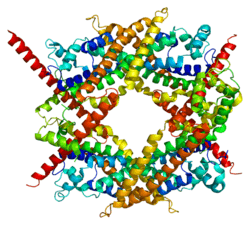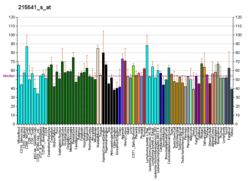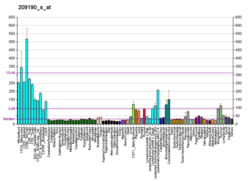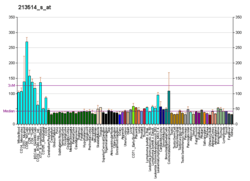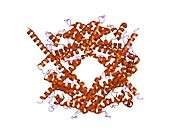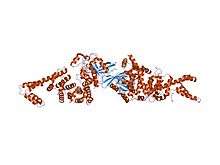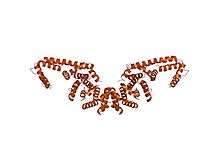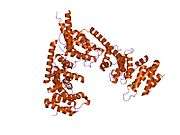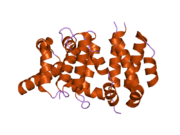DIAPH1
Protein diaphanous homolog 1 is a protein that in humans is encoded by the DIAPH1 gene.[5][6][7]
Function
This gene is a homolog of the Drosophila diaphanous gene and belongs to the protein family of the formins, characterized by the formin homology 2 (FH2) domain. It has been linked to autosomal dominant, fully penetrant, nonsyndromic low-frequency progressive sensorineural hearing loss. Actin polymerization involves proteins known to interact with diaphanous protein in Drosophila and mouse. It has therefore been speculated that this gene may have a role in the regulation of actin polymerization in hair cells of the inner ear. Alternatively spliced transcript variants encoding distinct isoforms have been found for this gene.[7]
Clinical significance
Mutations in this gene have been associated with macrothrombocytopenia and hearing loss,[9] microcephaly, blindness, and early onset seizures[10]
Its actions on platelet formation appear to occur at the level of the megakaryocyte where it is involved in cytoskeleton formation.[11]
See also
References
- GRCh38: Ensembl release 89: ENSG00000131504 - Ensembl, May 2017
- GRCm38: Ensembl release 89: ENSMUSG00000024456 - Ensembl, May 2017
- "Human PubMed Reference:". National Center for Biotechnology Information, U.S. National Library of Medicine.
- "Mouse PubMed Reference:". National Center for Biotechnology Information, U.S. National Library of Medicine.
- Lynch ED, Lee MK, Morrow JE, Welcsh PL, León PE, King MC (November 1997). "Nonsyndromic deafness DFNA1 associated with mutation of a human homolog of the Drosophila gene diaphanous". Science. 278 (5341): 1315–8. doi:10.1126/science.278.5341.1315. PMID 9360932.
- Leon PE, Raventos H, Lynch E, Morrow J, King MC (June 1992). "The gene for an inherited form of deafness maps to chromosome 5q31". Proceedings of the National Academy of Sciences of the United States of America. 89 (11): 5181–4. doi:10.1073/pnas.89.11.5181. PMC 49253. PMID 1350680.
- "Entrez Gene: DIAPH1 diaphanous homolog 1 (Drosophila)".
- Riento K, Guasch RM, Garg R, Jin B, Ridley AJ (June 2003). "RhoE binds to ROCK I and inhibits downstream signaling". Molecular and Cellular Biology. 23 (12): 4219–29. doi:10.1128/MCB.23.12.4219-4229.2003. PMC 156133. PMID 12773565.
- Stritt S, Nurden P, Turro E, Greene D, Jansen SB, Westbury SK, et al. (June 2016). "A gain-of-function variant in DIAPH1 causes dominant macrothrombocytopenia and hearing loss". Blood. 127 (23): 2903–14. doi:10.1182/blood-2015-10-675629. PMID 26912466.
- Al-Maawali A, Barry BJ, Rajab A, El-Quessny M, Seman A, Coury SN, et al. (February 2016). "Novel loss-of-function variants in DIAPH1 associated with syndromic microcephaly, blindness, and early onset seizures". American Journal of Medical Genetics. Part A. 170A (2): 435–40. doi:10.1002/ajmg.a.37422. PMC 5315085. PMID 26463574.
- Pan J, Lordier L, Meyran D, Rameau P, Lecluse Y, Kitchen-Goosen S, et al. (2014). "The formin DIAPH1 (mDia1) regulates megakaryocyte proplatelet formation by remodeling the actin and microtubule cytoskeletons". Blood. 124 (26): 3967–77. doi:10.1182/blood-2013-12-544924. PMID 25298036.
Further reading
- Reinhard M, Giehl K, Abel K, Haffner C, Jarchau T, Hoppe V, Jockusch BM, Walter U (April 1995). "The proline-rich focal adhesion and microfilament protein VASP is a ligand for profilins". The EMBO Journal. 14 (8): 1583–9. doi:10.1002/j.1460-2075.1995.tb07146.x. PMC 398250. PMID 7737110.
- Andersson B, Wentland MA, Ricafrente JY, Liu W, Gibbs RA (April 1996). "A "double adaptor" method for improved shotgun library construction". Analytical Biochemistry. 236 (1): 107–13. doi:10.1006/abio.1996.0138. PMID 8619474.
- Yu W, Andersson B, Worley KC, Muzny DM, Ding Y, Liu W, Ricafrente JY, Wentland MA, Lennon G, Gibbs RA (April 1997). "Large-scale concatenation cDNA sequencing". Genome Research. 7 (4): 353–8. doi:10.1101/gr.7.4.353. PMC 139146. PMID 9110174.
- Fujiwara T, Mammoto A, Kim Y, Takai Y (May 2000). "Rho small G-protein-dependent binding of mDia to an Src homology 3 domain-containing IRSp53/BAIAP2". Biochemical and Biophysical Research Communications. 271 (3): 626–9. doi:10.1006/bbrc.2000.2671. PMID 10814512.
- Kato T, Watanabe N, Morishima Y, Fujita A, Ishizaki T, Narumiya S (February 2001). "Localization of a mammalian homolog of diaphanous, mDia1, to the mitotic spindle in HeLa cells". Journal of Cell Science. 114 (Pt 4): 775–84. PMID 11171383.
- Westendorf JJ (December 2001). "The formin/diaphanous-related protein, FHOS, interacts with Rac1 and activates transcription from the serum response element". The Journal of Biological Chemistry. 276 (49): 46453–9. doi:10.1074/jbc.M105162200. PMID 11590143.
- Sahai E, Marshall CJ (June 2002). "ROCK and Dia have opposing effects on adherens junctions downstream of Rho". Nature Cell Biology. 4 (6): 408–15. doi:10.1038/ncb796. PMID 11992112.
- Montagnoli A, Bosotti R, Villa F, Rialland M, Brotherton D, Mercurio C, Berthelsen J, Santocanale C (June 2002). "Drf1, a novel regulatory subunit for human Cdc7 kinase". The EMBO Journal. 21 (12): 3171–81. doi:10.1093/emboj/cdf290. PMC 126049. PMID 12065429.
- Tominaga T, Meng W, Togashi K, Urano H, Alberts AS, Tominaga M (December 2002). "The Rho GTPase effector protein, mDia, inhibits the DNA binding ability of the transcription factor Pax6 and changes the pattern of neurite extension in cerebellar granule cells through its binding to Pax6". The Journal of Biological Chemistry. 277 (49): 47686–91. doi:10.1074/jbc.M207539200. PMID 12324464.
- Gevaert K, Goethals M, Martens L, Van Damme J, Staes A, Thomas GR, Vandekerckhove J (May 2003). "Exploring proteomes and analyzing protein processing by mass spectrometric identification of sorted N-terminal peptides". Nature Biotechnology. 21 (5): 566–9. doi:10.1038/nbt810. PMID 12665801.
- Vicente-Manzanares M, Rey M, Pérez-Martínez M, Yáñez-Mó M, Sancho D, Cabrero JR, Barreiro O, de la Fuente H, Itoh K, Sánchez-Madrid F (July 2003). "The RhoA effector mDia is induced during T cell activation and regulates actin polymerization and cell migration in T lymphocytes". Journal of Immunology. 171 (2): 1023–34. doi:10.4049/jimmunol.171.2.1023. PMID 12847276.
- Stüven T, Hartmann E, Görlich D (November 2003). "Exportin 6: a novel nuclear export receptor that is specific for profilin.actin complexes". The EMBO Journal. 22 (21): 5928–40. doi:10.1093/emboj/cdg565. PMC 275422. PMID 14592989.
- Yasuda S, Oceguera-Yanez F, Kato T, Okamoto M, Yonemura S, Terada Y, Ishizaki T, Narumiya S (April 2004). "Cdc42 and mDia3 regulate microtubule attachment to kinetochores". Nature. 428 (6984): 767–71. doi:10.1038/nature02452. PMID 15085137.
- Mammoto A, Huang S, Moore K, Oh P, Ingber DE (June 2004). "Role of RhoA, mDia, and ROCK in cell shape-dependent control of the Skp2-p27kip1 pathway and the G1/S transition". The Journal of Biological Chemistry. 279 (25): 26323–30. doi:10.1074/jbc.M402725200. PMID 15096506.
- Rundle DR, Gorbsky G, Tsiokas L (July 2004). "PKD2 interacts and co-localizes with mDia1 to mitotic spindles of dividing cells: role of mDia1 IN PKD2 localization to mitotic spindles". The Journal of Biological Chemistry. 279 (28): 29728–39. doi:10.1074/jbc.M400544200. PMID 15123714.
- Carreira S, Goodall J, Denat L, Rodriguez M, Nuciforo P, Hoek KS, Testori A, Larue L, Goding CR (December 2006). "Mitf regulation of Dia1 controls melanoma proliferation and invasiveness". Genes & Development. 20 (24): 3426–39. doi:10.1101/gad.406406. PMC 1698449. PMID 17182868.
